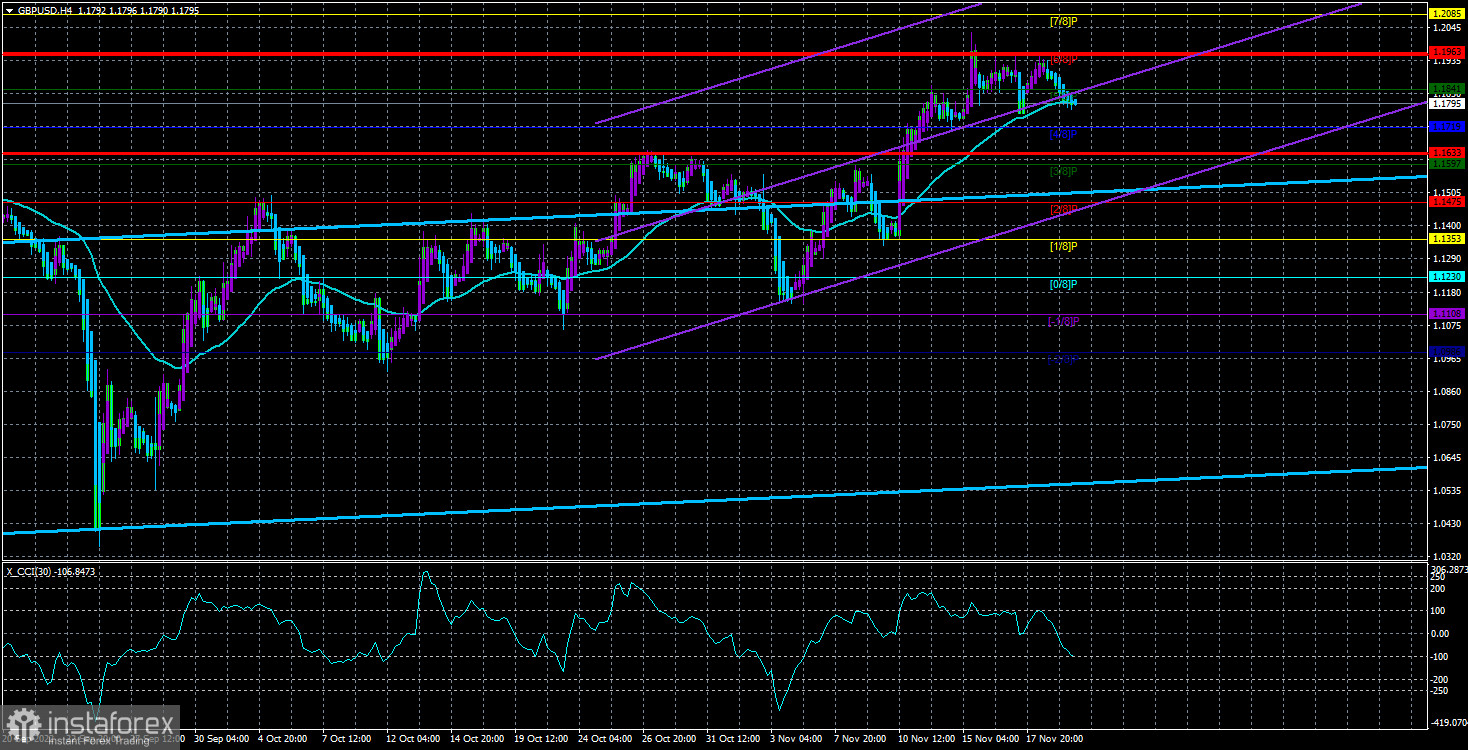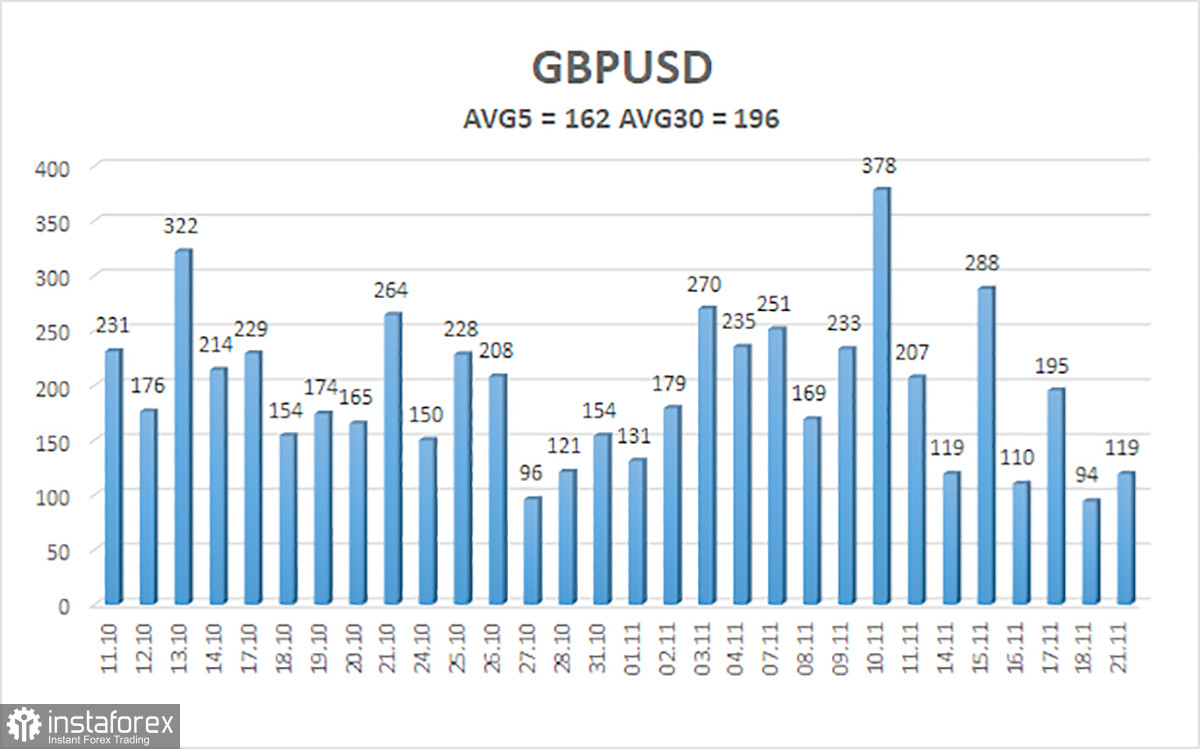
On Monday, the GBP/USD currency pair was also moving lower. Still, it was a weaker downward movement, and it has yet to be possible to surpass the moving average line decisively. In addition, the price has failed to move past the Murray level of "6/8" or 1.1963, so we anticipate a significant downward correction of at least 300–400 points. Recall that we currently see no justification for increasing the pound or the dollar. The last few weeks have seen a fairly significant strengthening in the pound sterling, which does not quite match the fundamental and macroeconomic background. The most logical course of action, therefore, remains correction. Additionally, there weren't many noteworthy occurrences or publications last week, and the market demonstrated that it was no longer willing to purchase the pound rashly in the absence of news and reports. This week will feature even less news and reports, so it's time to get used to that. However, sell signals must start to form to calculate a potential decline in quotes. Any fundamental theory, or even a theory, should be supported by distinct trading signals.
When viewed in its entirety, the situation is quite perplexing. The Fed rate was actively and rapidly increasing, but the market was unconcerned about what to do with the dollar. But as the Fed's monetary policy tightening accelerates, the Bank of England keeps raising interest rates. However, experts do not anticipate that the BA rate will increase to 6%. That is, to a point where lowering inflation to 2% will likely be possible. Despite eight increases in the BA rate, the consumer price index in the UK keeps rising. The pound officially has grounds for continuing growth against the dollar because the British regulator may raise the rate by 0.75% one or two more times, but who can now say with certainty when these increases will be?
Britain's economy is already in recession.
The "risk zone" in which the British economy is most vulnerable. Recall that while there is much discussion about it right now, it is not certain that the American economy will enter a recession. The European economy will also do so, but it is likely that it won't be severe or long-lasting. However, Jeremy Hunt and Andrew Bailey assert that the British economy has already entered a recession. Additionally, the UK's population's standard of living is declining, and inflation is still on the rise. Jeremy Hunt claims that the state's payment to the populace for electricity costs will be less than anticipated and that taxes will go up for some groups of citizens. Thus, the most challenging economic situation is currently occurring in the UK, which could result in a new decline in the pound's value, short of a catastrophe.
The impact of macroeconomic statistics on market sentiment is typically very muted. The reaction typically only has a local impact. Imagine, though, if within a year or two, all or nearly all of the macroeconomic indicators for the UK decline. Similar trends can also be seen domestically (the first two quarters of GDP, for example), but experts do not anticipate a significant collapse abroad. Both central banks will eventually stop raising interest rates, at which point macroeconomic statistics might become more significant. Alternatively, the state of the economy. Additionally, the British pound may suffer if the British economy is in a terrible state. Naturally, this is still a long-term possibility. How long the BA will increase the rate is still a mystery. We do not see compelling arguments for the dollar's continued rise or the US currency's return to global expansion. We are most likely anticipating a protracted consolidation. In any case, you need to pay close attention to the technical indicators that react to shifts in market sentiment the best.

Over the previous five trading days, the GBP/USD pair has experienced an average volatility of 162 points. This value for the dollar/pound exchange rate is "very high." Thus, we anticipate movement inside the channel on Tuesday, November 22, constrained by the levels of 1.1633 and 1.1961. An upward turn of the Heiken Ashi indicator will indicate a potential continuation of the upward movement.
Nearest levels of support
S1 – 1.1719
S2 – 1.1597
S3 – 1.1475
Nearest levels of resistance:
R1 – 1.1841
R2 – 1.1963
R3 – 1.2085
Trading Suggestions:
In the 4-hour timeframe, the GBP/USD pair has begun a new round of downward correction. In the event of a price rebound from the moving average at this time, purchase orders with targets of 1.1963 and 1.2085 should still be taken into account. With targets of 1.1719 and 1.1633, open sell orders should be fixed below the moving average.
Explanations of the illustrations:
Linear regression channels – help to determine the current trend. The trend is strong if both are directed in the same direction.
The moving average line (settings 20.0, smoothed) – determines the short-term trend and the direction in which trading should be conducted now.
Murray levels – target levels for movements and corrections.
Volatility levels (red lines) – the likely price channel in which the pair will spend the next day, based on current volatility indicators.
The CCI indicator – its entry into the oversold area (below -250) or into the overbought area (above +250) means that a trend reversal in the opposite direction is approaching.





















